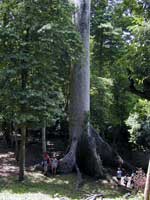Land of the Maya
The Tree Of Life
The tree of life is a common symbol in many cultures. To the Maya, the sacred Ceiba tree connects the three layers of the world. The roots reach into the underworld of death, the trunk is in the middleworld of life, and the branches reach up into the upperworld of paradise.

The Ceiba tree is a tall tree with large buttressed roots, a remarkably straight trunk, and a high horizontal crown. A majestic tropical tree and appropriate symbol for the complex interactions within the environment. The giant limbs of the Ceiba's umbrella-shaped crown are laden with aerial plants and provide a home for countless species of animals. Birds feed and nest in the tree's high perches, mammals use the enormous limbs as aerial highways, frogs raise their tadpoles in the tiny pools that collect in bromeliads, and insects reach the peak of their diversity in the canopy of giant trees like the Ceiba. The roots are said to shelter bats, symbolic of the underworld. The trunk teems with insect life, and attracts the animals and birds that feed on them. The crown spreads wide over
The jungle canopy, often with four branches that would suggest the four cardinal directions that are so significant to the Maya.
A Ceiba could be found at the center of most pre-Columbian Mesoamerican villages. Ceiba flowers served as the pattern for ear flares worn by Classic Maya kings.
This ancient tablet is located in the Temple of the Foliated Cross in the Maya Site of Palenque in Mexico. It is one of the three temples in Palenque, known as the Group of the Cross. This temple was built by King Chan-Bahlum to commemorate and celebrate his accession rites to the throne after the death of his father, king Pacal.

From 698 AD Found in the
Temple of the Foliated Cross
The tablet shows Chan Bahlum on the left side, dressed simply with a loin cloth and his long hair wrapped in readiness to don the heavy headdress of kingship. His father Pacal stands on the other side, dressed for burial. Pacal holds the insignia of royal power, the passing of authority will occur at the end of the ten days of accession rites.
In the center we see a variant of the tree of life formed by a maize plant rising from a band of water and the Kan-cross Waterlily Monster, which symbolizes the waters of the earth as the source of life. In the crown of the tree sits a huge water bird wearing the mask of the Celestial Bird. The branches of the tree are ears of maize manifested as human heads since in Maya tradition, human flesh was made from maize dough. Pacal is shown giving to his son a personified blood letter, an instrument for bloodletting rituals and vision quests. It drew the blood of the King and brought on the trance that opened the portal to Shivalva or Maya underworld.
